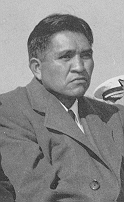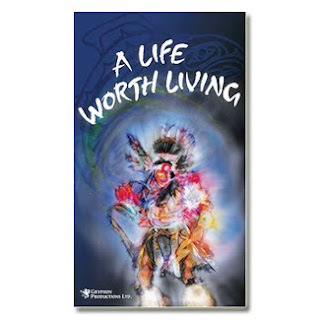 Manitoba's Aboriginal population is active politically. We have our share of Indians in main stream politics and a number of politic organizations engaged in the larger community.
Manitoba's Aboriginal population is active politically. We have our share of Indians in main stream politics and a number of politic organizations engaged in the larger community.Ron Evans is the Grand-Chief, Assembly of Manitoba Chiefs. He is elected by the Chiefs of Manitoba (64). I am not sure how much of the sixty-four votes he needs to be elected. He represents the Chiefs of the 64 Bands in Manitoba, and by default is seen to represent the People of those Bands.

David Chartrand is the elected President of Manitoba Metis Federation. Chartrand has just been re-elected as leader of the Metis. Approximately three thousand eight hundred MMF members voted for him. His opponent received less than eight hundred votes. Chartrand can speak Saulteaux (Ojibway-Anishinabemowin).

The Honourable Eric Robinson is a Member of the Legislative Assembly (MLA) for the Province Manitoba, and Minister of Aboriginal and Northern Affairs and Deputy Premier of Manitoba. Robinson represents the electoral area of Rupertsland. There are approximately sixteen thousand people in the voting area. A little less than ninety percent of those people are Aboriginal. Robinson has been elected as MLA since 1993.
He has enjoyed a loyal following from the people of Rupertsland, having received the largest percentage majority of votes in the province.
There are many Indians and groups dipping their feet in the political pool in Manitoba. For a larger picture of the many many players in the Manitoba the Turtle Island Native Network has a listing of groups.
There are a number of Aboriginal people that are currently players in the political arena: George Hicks, MLA and Speaker of the House Manitoba. Frank Whitehead, MLA The Pas. Morris Swan-Shannacappo GrandChief Southern Chiefs Organization (SCO). David Harper, GrandChief Manitoba Keewatinowi Okimakanak (MKO). Regional Chief Bill Traverse for Assembly of First Nations (AFN). This is a small list of the people that are swimming in the political lake in Manitoba. I won't bother to list other's as they are minnows considering the size of the Lake.
Of the politicians for Aboriginal people Eric Robinson swings the biggest stick. He is clearly elected by the people. Represents more people and is in a position that directly affects Aboriginal people. Some would argue that he is provincial politics and it does not have the same measure as an Aboriginal (Native) organization. Those people are dead wrong and stupidly naive. Provincial politics sticks it's arm down the throat of Indian life, even if we don't want it. All we have to do is look at section 92 of the Canadian Constitution. In any case Provincial legislation is in our backyards and in our homes; even on the Reserve. We, as Indians have always said that our relationship is with the Crown.
By way of attrition our Rights have been taken over by Provincial legislation and policy. That is the major reason that Robinson holds so much power. His government holds Indians at their mercy.
Robinson is in a conundrum; he is a representative of the Provincial government and he is a Treaty Indian. He must represent the larger population and the follow the road-map of the government (his government) and their political ideology. He also has links to the Aboriginal community due to his heritage. His constituency is largely Aboriginal and those are the people that elect him into his position. The Aboriginal population's interests do not (mostly) jive with the provincial government. Robinson is accountable to his constituency and is accountable to his political party. The party is bigger than the individual. He has to deal with listening to his electorate, which is the north and Aboriginal, plus he has to listen to what the government (his political party) wishes to accomplish. In addition he is an Indian so his loyalty, integrity is always in crisis. The government aims to stay in power. In order to stay in power, their policies must please the masses. The masses are mindful of the government coin purse. Government can not bend to the wills of the Aboriginal lobby. Robinson has to look at himself in the mirror everyday and ask himself which master he is going to serve that day; heritage, constituency (which is Aboriginal), or the political party he is a member of. A very hard position to be in. One of the reasons I say a politician is a contortionist, he must be pliable.
Ron Evans wishes to have what Eric Robinson has, legitimacy, power and influence. His master is the 64 Chiefs of Manitoba. He is elected by approximately 35 people. He has no real power or influence. Although he conducts himself as though he has power, in reality he is a glorified manager. It is probably frustrating for Evans as he was once Chief of his own community. In that position he could deal out favours at his pleasure, deal out punishment by with holding services and resources of the community. In his current position he must bend at the pleasure of the Chiefs. This must be upsetting being mastered by his once peers. I still see he is trying to conduct business as he did in his community. I understand that he can keep quite a tally on people that do not agree with his decisions. In any case the Assembly of Manitoba Chiefs is an organization with potential. If they can become a legitimate representation of the Aboriginal people. As it is right now, AMC is an ineffective lobby group grappling with identity issues. Leadership that has no idea on the role of a visionary.
David Chartrand is the leader of the Manitoba Metis. He is the best at promotion. He promotes the MMF so much that the organization is now synonymous with his face. He makes regular appearance on radio shows, is in the news with soundbites with any issue that is related (and in many cases not related) to Aboriginal issues. He has an easier job that any of the other leaders. He only has to please a few key members of the Metis population. He is the manager of a lot of resources and uses that power as a sword (envision King Arthur wielding Excalibur). He is the king of the Metis and he rules in that manner.
There are many players but I think they all want to be king or queen. There are some very effective lobbyist working for Indians today. The problem with all the groups is that they are dependent on the larger governments for their survival; cash. How can our minds be independent when we have to serve that master? Each of the leaders want to be part of something that is grandiose, so they label themselves with titles that reflect this desire (the grandest grand). Sadly many of the grandiose organizations and leaders suffer from impotence. That impotence is due partially to systemic, structural shortcomings and also due to intellectual disability.
The problem with our players over here is that they are reactionary rather than proactive. They lack direction or initiative. The only time you see any type of action (with the exception of Chartrand who loves the media and promotes himself with abandon)is if an issue is in the news. Without any issue glaring them in the face they are sitting in the office or going out for photo-ops. No strategy or real identity for these organizations.













